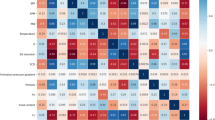Abstract
This work investigates the possible improvements that a stacked ensemble can provide to NO2 estimations in a monitoring network located in the Bay of Algeciras (Spain). In the proposed ensemble, ANNs, linear and nonlinear genetic algorithms models have been used as the individual learners in the first stage. The non-linear GA models produce better results than linear GA models as they are able to detect useful relationships between variables that are ignored in the linear case. The outputs of the individual learners have been employed as the inputs of the ANN models of the second stage. The most accurate of these models produced the final NO2 estimation. The obtained results are promising as this final stage-2 model is able to outperform all the other estimation models considered in this work. This can be explained due to its ability to exploit the advantages offered by each individual model from stage-1 and then find an optimal combination of their outputs in order to increase the global estimation performance. The improvement of these NO2 estimations can be very useful to improve the autonomous capacities for monitoring networks.
Access this chapter
Tax calculation will be finalised at checkout
Purchases are for personal use only
Similar content being viewed by others
References
Drucker, H., Cortes, C., Jackel, L.D., LeCun, Y., Vapnik, V.: Boosting and other ensemble methods. Neural Comput. 6, 1289–1301 (1994). https://doi.org/10.1162/neco.1994.6.6.1289
Breiman, L.: Bagging predictors. Mach. Learn. 24, 123–140 (1996). https://doi.org/10.1007/BF00058655
Breiman, L.: Random forests. Mach. Learn. 45, 5–32 (2001). https://doi.org/10.1023/A:1010933404324
Freund, Y., Schapire, R.E.: Experiments with a new boosting algorithm. In: Machine Learning International Workshop, pp. 148–156 (1996)
Ting, K.M., Witten, I.H.: Issues in stacked generalization. J. Artif. Int. Res. 10, 271–289 (1999)
Rivera, C., et al.: Spatial distribution and transport patterns of NO2 in the Tijuana - San Diego area. Atmos. Pollut. Res. 6, 230–238 (2015)
Finlayson-Pitts, B.J., Pitts, J.N.J.: The atmospheric system. In: Finlayson-Pitts, B.J., Pitts, J.N.J. (eds.) Chemistry of the Upper and Lower Atmosphere: Theory, Experiments, and Applications, pp. 15–42. Academic Press, San Diego (2000)
Faustini, A., Rapp, R., Forastiere, F.: Nitrogen dioxide and mortality: review and meta-analysis of long-term studies. Eur. Respir. J. 44, 744–753 (2014)
Westmoreland, E.J., Carslaw, N., Carslaw, D.C., Gillah, A., Bates, E.: Analysis of air quality within a street canyon using statistical and dispersion modelling techniques. Atmos. Environ. 41, 9195–9205 (2007)
Rumelhart, D.E., Hinton, G.E., Williams, R.J.: Learning internal representations by error propagation. In: Rumelhart, D.E., McClelland, J.L., PDP Research Group (eds.) Parallel Distributed Processing: Explorations in the Microstructure of Cognition. Foundations, vol. 1, pp. 318–362. MIT Press, Cambridge (1986)
Hornik, K., Stinchcombe, M., White, H.: Multilayer feedforward networks are universal approximators. Neural Netw. 2, 359–366 (1989). https://doi.org/10.1016/0893-6080(89)90020-8
Marquardt, D.W.: An algorithm for least-squares estimation of nonlinear parameters. J. Soc. Ind. Appl. Math. 11, 431–441 (1963)
Gardner, M.W., Dorling, S.R.: Artificial neural networks (the multilayer perceptron)—a review of applications in the atmospheric sciences. Atmos. Environ. 32, 2627–2636 (1998). https://doi.org/10.1016/S1352-2310(97)00447-0
Turias, I.J., González, F.J., Martin, M.L., Galindo, P.L.: Prediction models of CO, SPM and SO2 concentrations in the Campo de Gibraltar Region, Spain: a multiple comparison strategy. Environ. Monit. Assess. 143, 131–146 (2008). https://doi.org/10.1007/s10661-007-9963-0
Muñoz, E., Martín, M.L., Turias, I.J., Jimenez-Come, M.J., Trujillo, F.J.: Prediction of PM10 and SO2 exceedances to control air pollution in the Bay of Algeciras, Spain. Stoch. Environ. Res. Risk Assess. 28, 1409–1420 (2014). https://doi.org/10.1007/s00477-013-0827-6
Turias, I.J., et al.: Prediction of carbon monoxide (CO) atmospheric pollution concentrations using meteorological variables. WIT Trans. Ecol. Environ. 211, 137–145 (2017). https://doi.org/10.2495/AIR170141
González-Enrique, J., Turias, I.J., Ruiz-Aguilar, J.J., Moscoso-López, J.A., Jerez-Aragonés, J., Franco, L.: Estimation of NO2 concentration values in a monitoring sensor network using a fusion approach. Fresen. Environ. Bull. 28, 681–686 (2019)
González-Enrique, J., Turias, I.J., Ruiz-Aguilar, J.J., Moscoso-López, J.A., Franco, L.: Spatial and meteorological relevance in NO2 estimations. A case study in the Bay of Algeciras (Spain). Stoch. Environ. Res. Risk Assess. 33, 801–815 (2019). https://doi.org/10.1007/s00477-018-01644-0
Holland, J.H.: Adaptation in Natural and Artificial Systems. University of Michigan Press, Ann Arbor (1975)
Goldberg, D.E.: Genetic Algorithms in Search, Optimization and Machine Learning. Addison-Wesley Longman Publishing Co., Inc., Reading (1989)
Polikar, R.: Ensemble based systems in decision making. Circuits Syst. Mag. IEEE. 6, 21–45 (2006). https://doi.org/10.1109/MCAS.2006.1688199
Willmott, C.J.: Some comments on the evaluation of model performance. Am. Meteorol. Soc. 63, 1309–1313 (1982)
Friedman, M.: The use of ranks to avoid the assumption of normality implicit in the analysis of variance. J. Am. Stat. Assoc. 32, 675–701 (1937). https://doi.org/10.1080/01621459.1937.10503522
Hochberg, Y., Tamhane, A.C.: Multiple Comparison Procedures. Wiley, New York (1987)
The Mathworks Inc.: Genetic Algorithm Options. https://es.mathworks.com/help/gads/genetic-algorithm-options.html
Acknowledgements
This work is part of the coordinated research projects TIN2014-58516-C2-1-R and TIN2014-58516-C2-2-R supported by MICINN (Ministerio de Economía y Competitividad-Spain). Monitoring data have been kindly provided by the Environmental Agency of the Andalusian Government.
Author information
Authors and Affiliations
Corresponding author
Editor information
Editors and Affiliations
Rights and permissions
Copyright information
© 2019 Springer Nature Switzerland AG
About this paper
Cite this paper
González-Enrique, J., Ruiz-Aguilar, J.J., Moscoso-López, J.A., Van Roode, S., Urda, D., Turias, I.J. (2019). A Genetic Algorithm and Neural Network Stacking Ensemble Approach to Improve NO2 Level Estimations. In: Rojas, I., Joya, G., Catala, A. (eds) Advances in Computational Intelligence. IWANN 2019. Lecture Notes in Computer Science(), vol 11506. Springer, Cham. https://doi.org/10.1007/978-3-030-20521-8_70
Download citation
DOI: https://doi.org/10.1007/978-3-030-20521-8_70
Published:
Publisher Name: Springer, Cham
Print ISBN: 978-3-030-20520-1
Online ISBN: 978-3-030-20521-8
eBook Packages: Computer ScienceComputer Science (R0)




